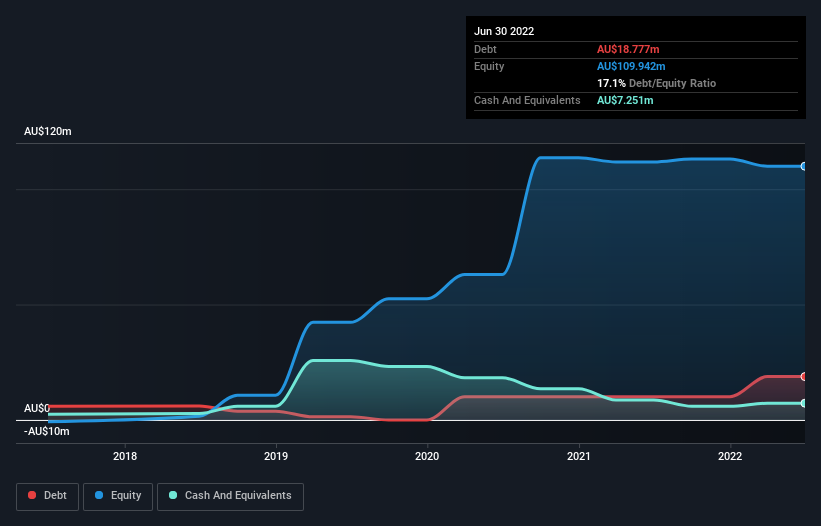Howard Marks put it nicely when he said that, rather than worrying about share price volatility, 'The possibility of permanent loss is the risk I worry about... and every practical investor I know worries about.' So it seems the smart money knows that debt - which is usually involved in bankruptcies - is a very important factor, when you assess how risky a company is. As with many other companies Ecofibre Limited (ASX:EOF) makes use of debt. But the more important question is: how much risk is that debt creating?
What Risk Does Debt Bring?
Debt is a tool to help businesses grow, but if a business is incapable of paying off its lenders, then it exists at their mercy. Part and parcel of capitalism is the process of 'creative destruction' where failed businesses are mercilessly liquidated by their bankers. However, a more common (but still painful) scenario is that it has to raise new equity capital at a low price, thus permanently diluting shareholders. Of course, plenty of companies use debt to fund growth, without any negative consequences. The first thing to do when considering how much debt a business uses is to look at its cash and debt together.
Our analysis indicates that EOF is potentially overvalued!
What Is Ecofibre's Debt?
The image below, which you can click on for greater detail, shows that at June 2022 Ecofibre had debt of AU$18.8m, up from AU$10.1m in one year. On the flip side, it has AU$7.25m in cash leading to net debt of about AU$11.5m.

How Strong Is Ecofibre's Balance Sheet?
According to the last reported balance sheet, Ecofibre had liabilities of AU$8.07m due within 12 months, and liabilities of AU$31.5m due beyond 12 months. On the other hand, it had cash of AU$7.25m and AU$8.07m worth of receivables due within a year. So its liabilities total AU$24.3m more than the combination of its cash and short-term receivables.
While this might seem like a lot, it is not so bad since Ecofibre has a market capitalization of AU$83.9m, and so it could probably strengthen its balance sheet by raising capital if it needed to. But we definitely want to keep our eyes open to indications that its debt is bringing too much risk. The balance sheet is clearly the area to focus on when you are analysing debt. But it is Ecofibre's earnings that will influence how the balance sheet holds up in the future. So if you're keen to discover more about its earnings, it might be worth checking out this graph of its long term earnings trend.
Over 12 months, Ecofibre reported revenue of AU$30m, which is a gain of 5.0%, although it did not report any earnings before interest and tax. We usually like to see faster growth from unprofitable companies, but each to their own.
Caveat Emptor
Over the last twelve months Ecofibre produced an earnings before interest and tax (EBIT) loss. Indeed, it lost a very considerable AU$23m at the EBIT level. Considering that alongside the liabilities mentioned above does not give us much confidence that company should be using so much debt. Quite frankly we think the balance sheet is far from match-fit, although it could be improved with time. However, it doesn't help that it burned through AU$13m of cash over the last year. So in short it's a really risky stock. The balance sheet is clearly the area to focus on when you are analysing debt. However, not all investment risk resides within the balance sheet - far from it. Be aware that Ecofibre is showing 3 warning signs in our investment analysis , and 2 of those shouldn't be ignored...
If you're interested in investing in businesses that can grow profits without the burden of debt, then check out this free list of growing businesses that have net cash on the balance sheet.
Valuation is complex, but we're here to simplify it.
Discover if Ecofibre might be undervalued or overvalued with our detailed analysis, featuring fair value estimates, potential risks, dividends, insider trades, and its financial condition.
Access Free AnalysisHave feedback on this article? Concerned about the content? Get in touch with us directly. Alternatively, email editorial-team (at) simplywallst.com.
This article by Simply Wall St is general in nature. We provide commentary based on historical data and analyst forecasts only using an unbiased methodology and our articles are not intended to be financial advice. It does not constitute a recommendation to buy or sell any stock, and does not take account of your objectives, or your financial situation. We aim to bring you long-term focused analysis driven by fundamental data. Note that our analysis may not factor in the latest price-sensitive company announcements or qualitative material. Simply Wall St has no position in any stocks mentioned.
About ASX:EOF
Ecofibre
Engages in the polymer, health care, and hemp seed genetics businesses in the United States and Australia.
Slight and slightly overvalued.
Market Insights
Community Narratives



